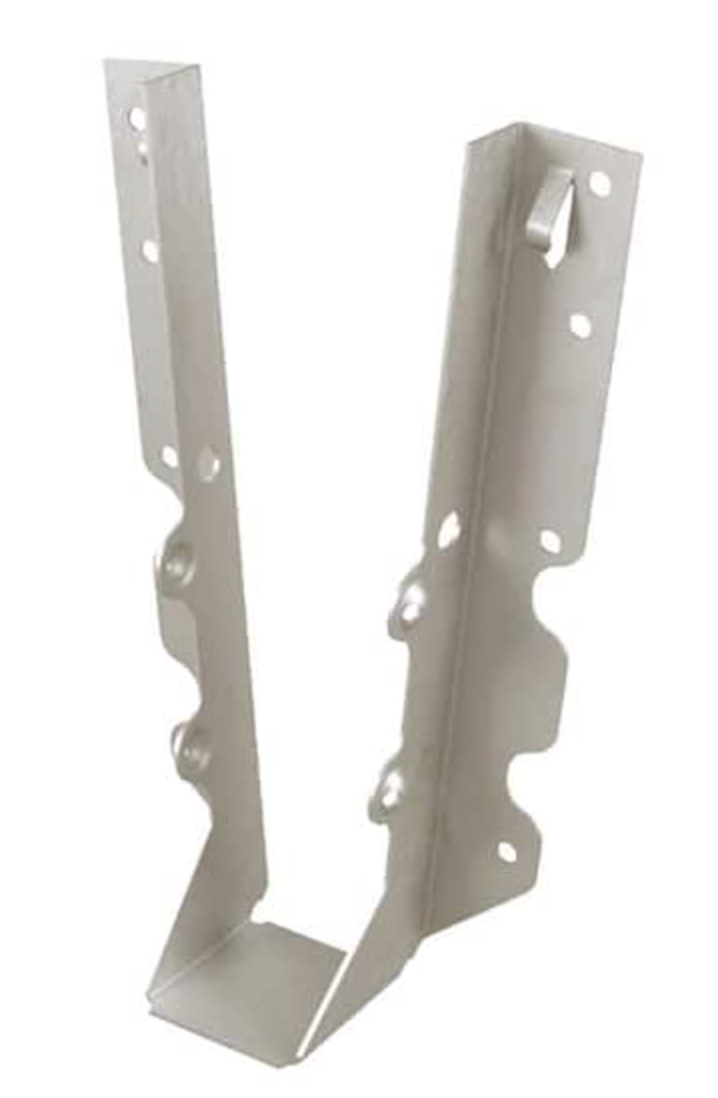Joist Connection
Deck joist framing into the side of a beam or ledger board (where the joist end connects) must be supported by approved joist hangers.
Hammer Test
The inspector should note missing connectors or fasteners. All lag screws should have washers. All bolts should have nuts and washers.

The illustration above shows a "hammer test." The framing members of a deck are only as reliable as the connections between them. And using a hammer to tap on the fasteners may provide some helpful information to the inspector using the hammer.
Depending on how the deck was built, vital connections may have degraded over time due to various factors. Issues such as wobbly railings, loose stairs, and ledgers that appear to be pulling away from the adjacent structure are all causes for concern. The tightness of fasteners should be checked. If it is not possible to reach both sides of a bolt, it may be struck with a hammer.
The ring of the hammer strike will sound hollow with vibration if the fastener is loose. The ring will sound solid if the connection is tight. The hammer test is subjective, so the inspector should hammer-test bolts that can be confirmed as tight or loose, and compare the sounds of the rings to develop a control.
Corrosion of Connectors and Fasteners All screws, bolts, and nails should be hot-dipped galvanized, stainless steel, silicon bronze, copper, zinc-coated or corrosion-resistant. Refer to 2021 IRC Table R507.2.3.
Nails and glulam rivets should be hot-dipped galvanized. Alternatively, they could be stainless steel, silicon bronze, or copper.
Bolts and lag screws, including nuts and washers, should be hot-dipped galvanized. Alternatively, they could be stainless steel, silicon bronze, or copper.

Typical joist hangers, straps, hold-downs, rafter clips, and other connectors intended for interior use are only coated to G90 weights of galvanization. The IRC requires all connectors on decks to be a minimum G185 galvanization or equivalent. Metal connectors should be G185 zinc-coated galvanized steel or post hot-dipped galvanized. Alternatively, they could be stainless steel.
Metal connectors and fasteners can corrode over time, especially if a product with insufficient corrosion resistance was originally installed. Corrosion of a fastener affects both the fastener and the wood. As the fastener corrodes, it causes the wood around it to deteriorate. As the fastener becomes smaller, the void around it becomes larger. Inspectors normally do not remove fasteners to check their quality or size, but if the inspector removes a fastener, he should make sure that removal doesn't result in a safety issue. Fasteners removed should be from areas that have the greatest exposure to weather. Some inspectors carry new fasteners to replace ones they remove at the inspection.
Lateral Connection
Refer to 2021 IRC R507.9.2. Lateral loads shall be transferred to the ground or to a structure capable of transmitting them to the ground. The IRC requires decks supported by the attachment to an exterior wall to be positively anchored to the primary structure, and be designed for both vertical and lateral loads. The vertical and lateral loads referred to are code-prescribed loads such as dead, live, wind, and seismic loads.
Attachment only to the band joist may not be sufficient for the lateral loads. Positive anchorage of the deck joist to the house's floor framing (as shown in the figure below) addresses this potential failure.

Where lateral load connections are installed at the deck, the inspector should observe hold-down tension devices installed in at least two locations per deck. And they should be installed within 24 inches (610 mm) of each end of the deck. Each device should have a stress design capacity of at least 1,500 pounds (6672 N). Refer to the figure above.
For new or replacement decks on existing homes, builders or homeowners must often remove interior wall or ceiling covering in order to install these large hold-down tension devices.

There is another type of lateral load connection that is permitted to be installed at the deck. They are surface-mounted. And the hold-down tension devices should be installed in at least four locations per deck. And each device should have a stress design capacity of not less than 750 pounds (3336 N). And one at least 24 inches from the end. Refer to the figure above.
These devices achieve an acceptable lateral load connection between the deck and primary structure (house) with the installation of these surface-mounted hold-down connection devices that are spread out along the length of the ledger and do not require opening up the interior wall or ceiling spaces nearby.
These devices provide a positive connection to the floor framing in order to resist the lateral loads.

The image above depicts a deck with post-to-joist diagonal bracing. Decks greater than 6 feet above grade could have diagonal bracing from posts to girder and from posts to joists. Diagonal bracing is required in some older building codes that didn't require lateral bracing. Deck post bracing that is installed in addition to required lateral bracing is not a defect.

The image above depicts a deck with post-to-girder diagonal bracing.
Free-standing decks (not supported by the home or building) should have diagonal bracing.

The illustration above depicts the underside diagonal bracing of a deck floor structure.
Decks greater than 6 feet above grade could have diagonal bracing across the bottoms of the joists to keep the deck square. A deck that is not held square could permit the outer posts to lean to the right or left, parallel to the ledger board, and thus twist the ledger away from the home or building.
Information used with permission of nachi.org
Comments